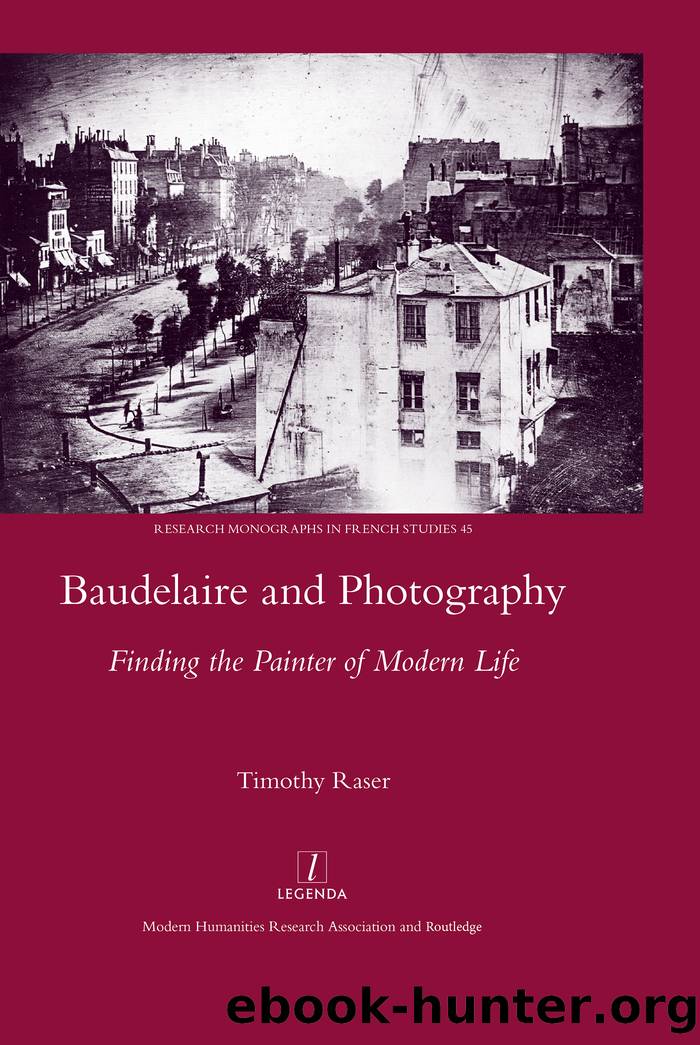Baudelaire and Photography by Raser Timothy;

Author:Raser, Timothy;
Language: eng
Format: epub
Publisher: Taylor and Francis
Published: 2014-08-15T00:00:00+00:00
It is evident that what the museum-goers do is not to be imitated, but it is not clear why one should not do so. Is it because they âpass rapidlyâ by works that have not been granted canonical status, and thus do not allow themselves to be touched by them? Or is it because their only knowledge of the canon comes from engravings, which reduce paintings to black-and-white images, thus diminishing their aesthetic quality? Or perhaps do they not really look at the Titians or the Raphaels, but recall them instead from the engravings that they saw earlier? Such an experience would not be authentic â that is, sensory, but the recollection, the memory of an earlier one. Or are such engravings just vulgar, produced as they are by mechanical means of reproduction?
Matters become more difficult still a page later when Baudelaire proposes that, since the canon is compromised, we grant greater consideration to the âminor artsâ, and asks us to appreciate the fashion plates of bygone generations. Indeed such illustrations are âminor artsâ, but they are also engraved: what invalidated visits to the museum now facilitates the appreciation of lesser works. Further, his consideration of minor artists is a prelude to his introduction of âM. G.â â Constantin Guys â who is certainly not a canonical artist, and whose works could only be seen as engravings in the Illustrated London News. Could one say then that the error of the museum-goers was to allow memory to interfere with perception, to allow the recollection an engraving to stand between them and what they saw, so much so that they didnât look at what they hadnât already seen, and saw only the traits of engravings when they were in front of Titians and Raphaels? Confirmation of this hypothesis comes later, when Baudelaire considers fashion plates and notes that the fashions depicted â from the Revolution and the Consulate â are those âsous lesquels nos pères se trouvaient tout aussi enchanteurs que nous-mêmesâ [âin which our fathers found themselves every bit as fascinating as we do ourselvesâ].11 He can admire Revolutionary or Consular fashions even though they are engraved because this is his only experience of these styles: his perception of the engravings is fresh, stimulating, exciting.
The possibility that it is strictly the novelty, the freshness of the sensation that makes something appealing is reasserted when, using the example of Edgar Poeâs âMan of the Crowdâ, Baudelaire likens the artist to a child, for âlâenfant voit tout en nouveautéâ [âThe child sees everything in a state of newnessâ].12 Later, he defines genius as this ability to appreciate the new: âle génie nâest que lâenfance retrouvée à volontéâ [âgenius is nothing more nor less than childhood recovered at willâ],13 where for children, everything is new. Despite its repudiation of the idea of beauty, the celebration of what is new is a genuine aesthetics because the new can only be apprehended by the senses: no identification, no recognition, no cognitive faculties are involved. Furthermore,
Download
This site does not store any files on its server. We only index and link to content provided by other sites. Please contact the content providers to delete copyright contents if any and email us, we'll remove relevant links or contents immediately.
Shoot Sexy by Ryan Armbrust(17133)
Portrait Mastery in Black & White: Learn the Signature Style of a Legendary Photographer by Tim Kelly(16478)
Adobe Camera Raw For Digital Photographers Only by Rob Sheppard(16380)
Photographically Speaking: A Deeper Look at Creating Stronger Images (Eva Spring's Library) by David duChemin(16151)
Bombshells: Glamour Girls of a Lifetime by Sullivan Steve(13100)
Art Nude Photography Explained: How to Photograph and Understand Great Art Nude Images by Simon Walden(12339)
Perfect Rhythm by Jae(4616)
Pillow Thoughts by Courtney Peppernell(3382)
The Book of Joy by Dalai Lama(3212)
Good by S. Walden(2909)
The Pixar Touch by David A. Price(2736)
Fantastic Beasts: The Crimes of Grindelwald by J. K. Rowling(2540)
A Dictionary of Sociology by Unknown(2516)
Humans of New York by Brandon Stanton(2376)
Read This If You Want to Take Great Photographs by Carroll Henry(2299)
Stacked Decks by The Rotenberg Collection(2266)
On Photography by Susan Sontag(2126)
Photographic Guide to the Birds of Indonesia by Strange Morten;(2086)
Insomniac City by Bill Hayes(2080)
